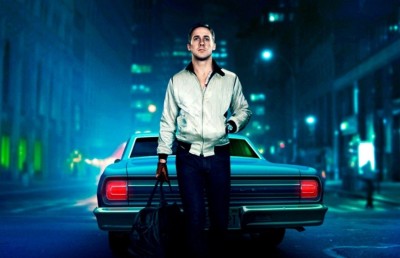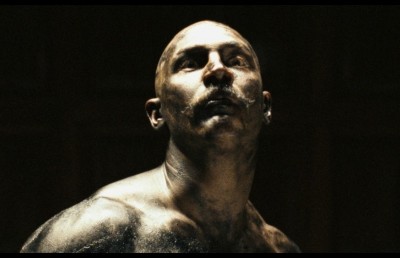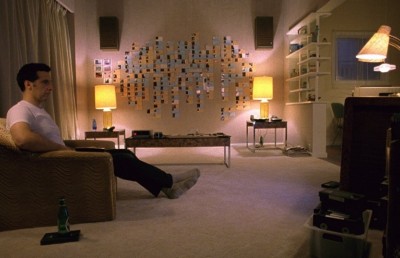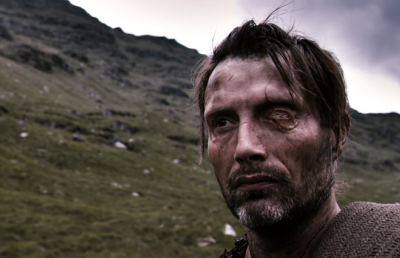Introduction: the gangster archetypes of Nicholas Refn

In light of the success of Drive (2011), Nicholas Refn’s Hollywood debut, scholars and cinephiles retroactively exploring his catalogue might think that the film’s carefully shot, mostly silent mood pieces were the culmination of a career-long stylistic quest in presenting masculine archetypes. After all, almost every Refn film including recent successes Bronson and Valhalla Rising, present masculine archetypes that are as violent as they are stylized, pointing towards a thematic and stylistic progression where the extraneous is methodically chipped away. By the time we get to Ryan Gosling’s nameless driver, this masculinity has been boiled down to sheer violence and saint-like compassion with little explanation for either: Gosling looks good in jeans but we’re never given a peak inside his head to understand why he does what he does. Conversely, Albert Brooks hams it up as the driver’s nemesis Bernie Rose, a pastiche of the aging Jewish gangster in Los Angeles, equally comfortable behind the deli counter as the boss’ desk – a man who left Brooklyn decades ago and who lives by immigrant codes. [1] Such extreme archetypes suit the needs of Hollywood’s larger than life fantasy worlds but if these are the results of a careful, career-long stripping back of characters by Refn, what did he start from? The answer lies in the messy, complex and all too human gangsters of the Pusher Trilogy.
Shot on video for the estimated princely sum of 6 million Danish Krone (1 millions USD), the original Pusher (1996) was a forgotten tangent of the 1990’s revolution in independent cinema: a gritty, violent flick more grindhouse than arthouse exploring the lives of European criminals, their social networks and the consequences of their lifestyles. But what began as a career-launching exercise in violent excess and music-video inspired visual flair became the surprising foundation for an expanded look at the root causes of Western Europe’s criminal class and the dire consequences of the cycle of violence and crime that dictates their lives. Rather than up the ante and indulge in a formulaic series of sequels, Refn instead chose to further investigate the human side of his characters, complementing his lo-fi violence with atypical stories and themes including the cycles of addiction, the trials of age and the lives of criminal immigrants in some of Europe’s most prosperous countries. Throughout these films, masculinity and hard men take center stage, men whose motivations are made abundantly clear, contrary to Refn & Gosling’s nameless driver so many years later.
By studying the role of masculinity, the film’s narrative and stylistic traits and the protagonists of each film, I hope to demonstrate the ways through which Nicholas Refn’s early work served not only as high-octane crime cinema for genre fans but also as an astute critique of the social conditions which keep the lower classes of his native Denmark trapped in a cycle of poverty and crime. By doing so, I intend to highlight how the themes he explores with these all-too-human gangsters would soon be refined and distilled into the archetypical characters of his later work, and what was gained and lost in the transition from the streets of Copenhagen to the highways of Los Angeles.
Narrative and style in the Pusher trilogyPusher (1996) was never meant to bear the weight of a trilogy as it was instead conceived to stand-alone as a quick, cheap and gritty directorial debut rather than the opening salvo of a multi-film treatise on crime. At best, the film was considered a risky bid for Refn, as he turned down a spot at the prestigious Danish Film institute to complete a movie that was anything but prestigious in tone [2] and that was never invited to a single festival. Yet in time, the film developed such a cult following on DVD that when Refn experienced financial woes, he returned to the series in order to pay off his debts. Why then did Pusher develop such a following in Europe?
The answer lies at least partially in its radical representation of European masculinity and criminality. While Hollywood provided no shortage of masculine archetypes from the superhero to the action hero to multiple generations of gangsters, these characters are created and exist through American eyes. American gangsters in particular are almost always presented as immigrants or sons of immigrants attempting to make it in the new world, away from the history and shackles of old Europe. Conversely, the most celebrated European films have explored the bourgeoisie (the majority of art house cinema), ancient heroes (Sword and Sandal epics), patriotic soldiers (films about Europe’s great wars), American heroes (Spaghetti Westerns) or have treated the poor as weak and downtrodden victims (Neo-realism). Even when dealing with criminality, Europe’s gangster films such as Pusher, contemporary La Haine by Mathieu Kassovitz or older French films such as Pepe Le Moko have framed the issue as one of immigrants (Muslim, African) vs. the European establishment.
Pusher however, undermines this image of bourgeois and civilized Europe by throwing the viewer into the heart of Denmark’s underworld, an underworld populated by toughs whose propensity towards alcohol, drugs, sex and violence is second to none. Exploring a hellish week in the life of Frank (Kim Bodnia), a low-level drug dealer in Copenhagen whose fate is sealed by a streak of bad luck, the film’s settings would be familiar for a generation of working class Europeans for whom the continent’s lauded social safety nets proved useless in escaping poverty. It is unsurprising that the film first found acclaim in England, a country already accustomed to the image of the football-crazed, hard-partying proletarian as the antithesis of the proper upper crust elite. [3]
Pusher thus deviates from the typical rise and fall of the gangster by providing no rise: Frank never escapes his hard luck existence nor does he ever seem intent to. Instead, the film’s first half is an exercise in bad boy wish fulfillment in which Frank and his partner Tonny (Mads Mikkelsen) eat, drink, snort, smoke and sleep their ways though the underworld. However, their lifestyle remains far from plush as these activities are simply treated as the perks of an otherwise ordinary criminal lifestyle. Frank and Tonny run errands in dilapidated public housing estates, grim streets, dirty nightclubs and stolen cars; casually conversing with each other with Mikkelsen’s Tonny adding a particular dash of levity through his humorous if crude commentary. The overall effect, punctuated by the film’s seven-day structure, is that of an ordinary week in Frank’s life rather than an extraordinary crime story. The ordinariness of the setting and casual attitude of the protagonists act as a counterweight to their excessive behavior: we’re not being shown something unusual, what’s extraordinary is how normal this sort of behavior is in Tonny and Frank’s lives.
While Pusher ’s events are made to appear ordinary, the film’s visual aesthetic is anything but as Refn pulls out every trick in the book to impress future potential backers – this being after all, a demo-reel as much as a genre exercise. Made in the wake of Pulp Fiction??’s referential excess and conceived at the height of the MTV generation’s sensory overload, it knows no subtlety, instead trading solely in excess. Though shot on what would now be considered extremely low-fidelity video equipment, this low resolution only enhances the film’s gritty visual style, one that commonly relies on the colored lighting of brothels and nightclubs to make up for a lack of resources. Though now arguably dated, this excess is no less impressive in the wake of Refn’s later films and subsequent developments in film style: ??Pusher is refreshingly irony free, reveling in its over the top violence, fast-paced editing and hand held camera movements. Though far from the ideological purity of the Danish Dogma movement of which it is a contemporary, the film’s use of low-budget equipment through necessity allowed Refn and his team to take risks absent from the second and third installments of the series which trade in this kinetic approach for a subdued methodology more befitting their dour narratives.
Unfortunately, the original Pusher ’s narrative suffers from a formulaic ending in which Frank meets his reckoning, with Refn spending more time crafting an iconoclastic visual style than a particularly innovative script. After losing a significant amount of drugs in a police bust, the anti-hero finds he must pay back his sadistic backer, the Croatian gangster Milo (Zlatko Buric) and his life quickly spirals out of control. Here, Refn’s lack of ambition is impossible to ignore: Pusher was meant as a cheap exploitation flick and the film’s initial dialogue-heavy observation gives way to a dramatic final scenario befitting just about any low budget genre piece. This trite ending however left the door open for Refn’s sequels to explore deeper themes while fleshing out his characters, freeing the trilogy from the constraints of the original.
Conceived as a way to pay off the million-dollar debt Refn found himself in after the commercial failure of Fear X, the Pusher sequels were a project the director wrote with a certain amount of reluctance. [4] If a low-budget crime thriller made for an excellent calling-card debut, a return to that style years later might seem like a step back or belie a lack of ideas. But while Pusher ’s narrative offered little of interest, the film’s universe presented opportunities for a more nuanced observation of criminal life in Europe. This however, demanded a new approach: abandoning the original film’s protagonist, episodic format, (comparatively) light hearted tone, visual excess and standard narrative arc, Refn instead conceived the sequels as extended observations of the Copenhagen underworld, closer in spirit to serialized television series than an individual gangster film. [5]
Pusher II: With Blood on my Hands??’s (2004) premise is a red-herring: starring Mads Mikkelsen as Tonny, Frank’s sidekick last seen coughing up blood in the original film, one might expect a lighter film than ??Pusher and exactly the kind rushed-sequel a struggling filmmaker directs for a much-needed cash. In a sly inversion however, Refn and Mikkelsen upend expectations by making a far more serious and contemplative film about the cycle of poverty and criminality that traps Europe’s underworld class from one generation to the next. Herein lies the biggest difference between Pusher and its sequels: while Refn’s first film had little say but plenty of ways to say it, With Blood on my Hands offers clear social commentary in the place of genre tropes, never sacrificing style but adding plenty of substance.
No longer restricted by Pusher ’s episodic weeklong format, Pusher II instead takes place over an undetermined period of time following Tonny’s release from prison. Ironically, while the film reprises the “Pusher” mantle, drugs are a far less central concern this time around. While Refn’s original film used narcotics both as a MacGuffin to drive the plot and as an excuse to show onscreen mayhem, we’re now presented with the troubling consequences of addiction on lower class criminal families. Even otherwise ridiculous moments are bittersweet: the wedding party in a drab red-lit bar complete with slot machines, pool tables and stripper could have been played for laughs to mock these lower class thugs but Refn wisely refrains from comedy and the party’s extended descent into intoxication becomes progressively grim.
Wisely, Refn tones down his previous hyper-stimulating approach, limiting the driving Techno music and quick editing in favor of a nuanced approach. Shot in order like all of Refn’s films, [6] Pusher II ’s wedding sequence makes use of this methodology as the camera slowly and subtly becomes increasingly wobbly, reflecting the drunken and chemically altered mood of the proceedings before sharply returning to order in the film’s moments of violence. This violence is also treated with more deference and respect than in the original where the over the top aesthetic made it almost cartoonishly extreme. Here, it is occasional, stark and painful, inflicted on women and family members, and always the result of emotional pain and scarring. These aesthetic shifts mark a substantial evolution in Refn’s filmmaking and while it can be argued that Pusher II is less exhilarating than its predecessor, it undoubtedly stands as a richer and better made film.
Critical reaction to I’m the Angel of Death: Pusher III (2005) was colored by surprise: surprise that Refn not only squeezed a good third film out of his low-brow concept, but more importantly that Pusher III was acclaimed as the best installment of the trilogy yet. In a series that began with an exciting if not entirely original take on the fall of a gangster, the surprisingly nuanced conclusion acts as a display of Refn’s growth not only as a writer but as a director, one now confident enough to know when to restrain from hyper-kinetic visuals and one adventurous enough to tackle issues of significance to society. Though not yet pointing towards the restrained minimalism of future works such as Valhalla Rising and Drive, by Pusher standards, I’m the Angel of Death is positively sedate, further minimizing the original film’s visual overdrive. Instead, Refn offers a character driven story punctuated by the kind of truly distressing carnage that would soon become his calling card.
This shift in approach to violence is perhaps the film’s most notable distinction. Whereas Pusher aped Tarantino’s over the top bloodshed and Pusher II saw the director moving in a more realistic direction, Pusher III finds him synthesizing these approaches into set pieces which both impress and disgust, simultaneously pleasing those looking for splatter-fest theatrics while turning this impulse against them as the situation becomes uncharacteristically uncomfortable. The first and only significant moments of bloodshed in the film occur when the film’s protagonist Milo (Zlatko Buric) murders a Polish pimp and a now rival drug dealer, quickly but brutally assaulting each with a hammer. This quick but painfully realistic occurrence mirrors the previous film’s frank depiction of street violence but it is the subsequent disposal of the bodies that truly set this film apart. With help from former associate Radovan (Slavko Labović, last scene in Pusher ), he hangs and guts the carcasses before disposing of the insides using the restaurant’s garbage disposal.
Refn spares us no detail of this admittedly revolting affair, clinically and dispassionately filming the process as if Milo were still cooking sarma in the kitchen. In contrast to the exaggerated camera movements and editing of the trilogy’s first film, this methodical approach is both more confident and more disturbing, giving the viewer no reprieve from the gore onscreen. Likewise the film’s other violent incident, Turkish gangster Mohamed’s asphyxiation, is completely bloodless but equally disconcerting due to the camera’s lingering gaze which only breaks to show us Milo retreating to smoke more heroin. Therein lies the film’s dual concerns: the brutality of violence and the fate of a feared gangster when he gets old, slows down and no longer stands as the hungriest, most intimidating figure in his city. While Pusher II focused on the cycle of poverty and criminality across generations, Pusher III is a rare look at the life of a successful gangster and whether that success is even worth it. Despite his reign of terror, Milo is still double-crossed by his associates, humiliated and backed into a corner. His hard won victories of a beautiful daughter and stable business are so fragile as to unravel within a single day. But perhaps it is to avoid retelling the same story thrice that Refn’s ambiguous fate for Milo is more optimistic than those of the previous films’ protagonists, though one gets a sense that all three will go on to live their own personal hells.
The protagonists of PusherSince the original Pusher was intended to be a cheap calling card for a young director, it was never meant to support a trilogy dealing with the aforementioned themes of family and the aging gangster. Nevertheless, while the film is both lighter in tone and less critical in theme than its sequels, it still remains poignant in its examination of the criminal underworld, pushing the perhaps hackneyed story of a down-on-his-luck drug dealer far beyond the typical clichés usually associated with such stock characters and pulp storylines. Yet all of the stereotypical elements of the gangster film are there: the hardboiled hero, the wise cracking sidekick, the seductive femme fatale, the ominous and untouchable crime lord and the petty victims. It is only when considered together and across three films that the true depth of this cast of characters is revealed. Though unplanned at the beginning of the trilogy, Refn retroactively transformed an ordinary crime film into the beginning of a much greater undertaking, borrowing from the grit of such serialized television as The Sopranos to expand the scope of his narrative.
Pusher ’s Frank is hardly a revolutionary protagonist. An amoral vessel for Refn’s visual pyrotechnics and the narrative’s violence, drug use and sexuality; his grim portrayal of criminal life differs little from previous “realistic” portrayals of the down on his luck gangster. Compared to the more developed leading men of the series’ sequels, his straightforward motivation and lack of compelling back-story do little to distinguish him from any other pulp protagonist, instead making him an ideal “every-gangster” through which to tell a story one is lead to believe is not particularly extraordinary but rather a sadly regular occurrence in the underworld of Europe. By the same token, this also makes Frank the protagonist viewers are most likely to identify with, his violent outbursts counterbalanced with tenderness for his girlfriend and his moral center stronger than Tonny’s hapless self-indulgences or Milo’s monstrous cruelty. His final betrayal at the hands of his femme-fatale lover in the back of a night club is heartbreaking rather than satisfying because no matter his transgressions, Refn and Bodnia imbue Frank with a sense of pathos and humanity and one senses that unlike his adversary (and Pusher III protagonist) Milo, he never asked for a life of violence. Nevertheless however, Frank’s end is as cliché as the Pusher trilogy would get and he stands as the most undistinguished of protagonists in a series that would elevate the post-millennial gangster film to new heights.
Much of the credit for this elevation goes to Mads Mikkelsen, who adds a layer of gravitas to the character of Tonny, originally conceived nearly a decade earlier as comic relief for Kim Bodnia’s Frank. A wise-cracking clown who ingloriously exits the first film after a savage beating at Frank’s hands, Tonny was a natural fit for what one expected from a Pusher sequel: a ridiculous caricature of a gangster who could only carry a ridiculous cash-in of a film. Surprisingly however, this turned out to be anything but the case. Though it was no easy task re-imagining a man with “respect” tattooed on the back of his head in comically overwrought gothic lettering as anything more than a vessel for jokes, in With Blood on my Hands we find Tonny a changed man having gone through years of prison with nothing to show for it.
Though he shows hints of the bon vivant from the original film, Mikkelsen portrays Tonny with a wounded sadness and a desire to prove himself as his own man. Refn’s maturity as a storyteller comes into focus here: while Pusher ’s second half felt like an obligatory and lazily predictable ending to a stylistic tour de force, the director now approaches his characters as more than vessels for carnage and debauchery, using his handheld camera and driving techno soundtrack to lighten what would otherwise be an extremely dour film. Together, Refn and Mikkelsen refashion Tonny as a man trapped in perpetual adolescence who realizes too late that he’s ruined too many chances and accumulated too much baggage to change, a far cry from Frank’s sullen gangster with a bad week.
The key theme is family. Even before Tonny is released from prison after the opening credits, we’re made aware that he is “The Duke’s son”. The Duke in question is Smeden (Leif Sylvester) a mid-level criminal operating a car-theft ring in Copenhagen. These terms and titles have consequences; Tonny never escapes his role as Smeden’s (failure of an) offspring and Smeden’s success is relative: he is still a petty criminal with no hope to escape his run down chop shop. The tension between the two is constant, as Tonny’s quest for respect and approval clashes with his father’s disappointment and frustration with a son he had long ago given up on as a successor and resigned himself to as a dependent. When Smeden de-facto anoints his employee Ø as his successor in a drunken, rambling speech at the latter’s wedding, counter shots of Tonny wincing from the insults reveal a man on at his breaking point.
The film’s other familial conflict comes from the revelation that Tonny fathered a son with a prostitute named Charlotte (Anne Sørensen) before going to jail. In addition to providing more torment for our hapless protagonist whose child’s mother alternates between insulting him and badgering him for money, this event profoundly changes Tonny and lies at the heart of Refn’s critique of the European criminality. While Tonny cannot live up to his father, he sees in Charlotte a reflection of his own troubled mother and can thus see no future for his son. Though Tonny does his best to take care of the child while Charlotte sniffs prodigious quantities of drugs, his idea of taking responsibility involves chastising Charlotte and choking her against a wall, starting the cycle of violence and neglect that led him down this path anew. Tonny cannot please his father and cannot save his son and while Refn’s film works as entertainment, the drab, sad lives he crafts for his characters are shot with a compassionate eye.
Of course, the film is not without its moments of levity. Tonny’s bone-headed theft of a Ferrari and a failed drug purchase by the aptly named “Kurt the Cunt” (Kurt Nielsen) camouflage the film’s seriousness –and prevent it from attaining respectability. Yet by the time Tonny gets asked to kill Smeden’s second son’s mother, another prostitute, the film has reached a moral nadir and Tonny a chemically depleted bottom. The film’s gory conclusion offers little hope with Tonny instead turning on his father and ultimately running off with his son but while he wants better for his child, can he achieve it? Nothing of his behavior across two films bodes well for his and his child’s future and the open ending (an aspect of all of Refn’s films) leaves us with more questions than answers.
Much as Mad Mikkelsen’s performance in Pusher II elevated the film beyond Refn’s debut, the director found a secret weapon for Pusher III in Zlatko Buric’s Milo. The only character to appear in all three films, Milo’s imposing menace was an essential if not particularly developed aspect of the first two films, making him another unlikely protagonist for the series’ conclusion. Nevertheless, transforming what was essentially a stock character (the gangster overlord) into a fully realized human being makes Refn’s point clear: each and every one of the gangsters populating Copenhagen’s streets have a story to tell complete with triumphs but more often than not, heartbreaks. Behind each stereotype and caricature lies a story –the Pusher Trilogy only tells a few.
But while fleshing out Milo’s character was an inspired choice, it is Buric’s performance that truly brings the aging mobster to life. Whereas most American films depict aging gangsters, those that have survived their youth, as wealthy retirees above the fray, Milo’s existence is so ramshackle as to make Tony Soprano resemble Don Corleone. Though not as desperate as Smeden, Milo’s aura of invincibility is shattered from the opening scene as we see him struggling with an addiction to his own poison in a narcotics anonymous meeting. From that moment on, Buric embodies Milo as a man struggling with the pressures of the dangerous and violent life he has made for himself, most often through the use of narcotics. To Refn and Buric’s credit, this revelation that Milo was as flawed and weak as his younger counterparts in the previous films never undermines his menace, instead proving that while he may not be stronger than Frank or Tonny, he is able to overcome his flaws through sheer ruthlessness.
Prior to Milo’s explosive use of violence however, we instead witness him suffering from something far more banal: middle age. On the morning of his daughter’s 25th birthday, Milo is not bashing in heads –he is negotiating for the price of flowers and worrying that he will not have time to cook a banquet feast. Even in his criminal activities, he’s completely out of touch: when he receives a shipment of ecstasy instead of heroin he has no idea how to sell it, for how much or even that the shipment is completely fake. His younger, hungrier Turkish associate Mohammed (Ilyas Agac) of a new generation of immigrants from a country even further off from Milo’s Croatia, has little patience for the aging gangster, resenting his strong-arm methods and demanding respect of his own.
Milo’s subsequent downfall initially resembles that of Frank or Tonny: he loses drugs and owes money to some very dangerous individuals, negatively affecting his relations with his loved ones as he all but misses his daughter’s 25th birthday. Unlike Frank and Tonny however, Milo’s cunning and experience insulates him from the worst consequences. From the moment he accepts heroin from ??Pusher II??’s Kurt (in a cameo appearance) Milo becomes increasingly unhinged, progressively losing the illusion of respectability and businessman-like appearance he’d projected. During his extortion at the hands of his creditors, who use his restaurant as the location for a white slavery deal, the aging lion can barely contain his anger.
Buric’s performance here immediately stands out, demonstrating a mixture of menace and restraint, as if he was barely containing an anger that would wipe out his adversaries. This fury explodes after an accidental ingestion of Polish speed when the aforementioned white slave attempts and escape only to be tortured by her captor. Though the link is never explicitly stated, the combination of drugs, humiliation and the girl’s resemblance to Milo’s own daughter push him over the edge as he brutally murders both the Polish pimp and the dealer whom originally sold him the ecstasy. From this moment on, Pusher III goes on a wildly different path than the previous two films, demonstrating what happens when the anti-hero actually comes out on top. The brutality of the violence reaches new heights but Milo nonetheless escapes whole and intact with only the film’s final shot of a tired, self-destructive man leaving hints that even in victory, a gangster’s life is a living hell with no possibility of escape. This emphasis on the stark consequences of violence is a far cry from Pusher ’s stylistic extravagance, demonstrating just how far Refn and his protagonists have come over the course of three films.
Conclusion: The Saga continuesGrowing from a ramshackle debut to a complex multi-part examination of criminal life, one might think the Pusher trilogy has all but exhausted itself, with Refn and co. having little left to say on the subject of gangsters, drugs and poverty in Europe. In a surprising twist however, Pusher III was not to be the film’s final installment: a remake directed by Spanish filmmaker Luis Prieto and executive produced by Refn toured the festival circuit as we went to publication. Moving the setting to England but once again co-starring Zlatko Buric as Milo, the film’s trailer cut the difference between the slick, Hollywood filmmaking that Refn has since moved onto and the violent description of European gangsterism that’s become the series’ hallmark. Though undoubtedly apart from Refn’s own films, one can hope that this reboot conserves the grit and complexity that made the original series so powerful, even as it demonstrates the Hollywood connections and sophistication that the films’ success allowed Refn to attain.
1 Cohen, Rich. Tough Jews. New York, NY: Simon & Schuster, 1998. 29. Print.
2 Westcott, Brad. “Crime Pays: An Interview with Nicolas Winding Refn.” Reverse Shot. N.p., Fall 2006. Web. 03 Nov. 2012.
3 Dunning, Eric, Patrick Murphy, and John Williams. The Roots of Football Hooliganism: An Historical and Sociological Study. London: Routledge & Kegan Paul, 1988. Print.
4 Westcott, Brad. “Crime Pays: An Interview with Nicolas Winding Refn.” Reverse Shot. N.p., Fall 2006. Web. 03 Nov. 2012.
5 Westcott, Brad. “Crime Pays: An Interview with Nicolas Winding Refn.” Reverse Shot. N.p., Fall 2006. Web. 03 Nov. 2012.
6 “Pusher II: Did You Know?” IMDb. IMDB.com, n.d. Web. 03 Nov. 2012.













